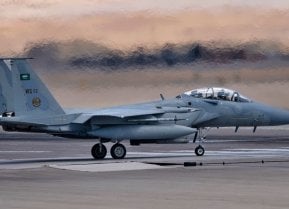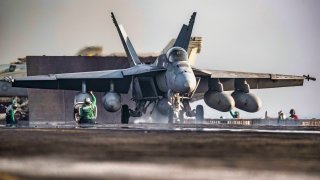Aircraft Carriers: The New Battleship (As in Old and Obsolete)?
Could the era of the U.S. Navy aircraft carrier dominating the world's oceans be over? Could the carrier end up obsolete like the battleships?
Are aircraft carriers obsolete like old battleships?
As military technology advances, tactics will be forced to adapt – as has always been the case. As defensive technologies advance, the deployment of aircraft carriers, a staple of force projection for almost one hundred years, is suddenly being questioned.
It was the sinking of the Moskva in 2022 that ignited a debate over the usefulness of surface ships, such as aircraft carriers, in modern warfare. The Moskva, a three-quarter-of-a-billion-dollar warship, sank after being hit with two R-360 Neptune anti-ship missiles (according to the Ukrainians, at least) – demonstrating that surface vessels were indeed vulnerable against modern defense systems.
Are Aircraft Carriers Vulnerable and Now Obsolete Like Battleships of Years Ago?
U.S. Navy Admiral James Stavridis wrote that the Moskva’s sinking “is a stark reminder of the vulnerability of surface ships – including aircraft carriers, the heart of the U.S. Navy – to relatively low-cost, numerous and technologically advanced cruise missiles.”
The cruise missiles that Stavridis describes are readily available, suggesting that America’s 11 nuclear aircraft carriers – plus the upcoming Ford-class carriers – may be at risk from relatively cheap tech, despite costing taxpayers $13 billion per unit.
“That gnawing worry focuses especially on Chinese ship-killing capabilities, which are far more advanced than anything Ukraine used to destroy Moskva,” Vanity Fair reported. “For the past two decades, China has been building up its maritime defenses. It now possesses a vast arsenal of land, sea, and air ship-targeting cruise and ballistic weapons.”
China also possesses hypersonic missiles – which America currently lacks the ability to defend against.
“In a single salvo, China could shoot swarms of hundreds of state-of-the-art hypersonic missiles traveling at multiple times the speed of sound and with ranges over a thousand miles,” Vanity Fair reported. “At present, several analysts believe that American carriers and other big ships operating in the littorals of the East and South China Sea would not last in the face of such an attack.”
Targeting Aircraft Carriers
The vulnerability of U.S. aircraft carriers is not just a hypothetical, but a suggested Chinese war strategy. In 2018, retired People’s Liberation Army Major General Luo Yuan said that the Chinese should launch a preemptive attack, Pearl Harbor-style, against U.S. aircraft carriers.
“Historical experience tells us that the United States is most afraid of people dying … If we sank one of their carriers, this would cause 5,000 casualties; if we sank two: 10,000 casualties – don’t you think America would be afraid?
Aircraft carriers are akin to floating cities, with 5,000 sailors aboard. The sinking of an aircraft carrier would have the potential to cause a mass casualty event – with more potential American casualties than the September 11th attack, or Operation Iraqi Freedom. And Luo is correct. Americans hold (American) life in high regard; the sinking of an aircraft carrier certainly has the potential to influence U.S. policy moving forward, perhaps undercutting the political support needed for such a conflict (hopefully, the American public appreciates – before something as significant as an aircraft carrier sinking – that direct conflict with China is ill-advised.) Undercutting political support is one deterrent. Undercutting the ability to wage war is another. To wage war in the Indo-Pacific, the U.S. would need to rely upon its aircraft carriers. If aircraft carriers were nullified, the U.S. would be dependent upon fixed air bases in the region – which would also be vulnerable to Chinese missile attacks.
Are The Threats Overstated?
Not everyone is convinced that U.S. aircraft carriers would be so vulnerable in modern conflict. Captain Paul Campagna, the commanding officer of the USS Dwight D. Eisenhower, said during a defense conference: “For anyone that’s worried about the modern threat that’s out there, I’ll just say that the carrier is not on an island … It deploys with the air wing. It deploys with the strike group. It deploys with a layered defense that goes from the bottom of the ocean and out to space, and anyone who thinks that we’re fragile, little teacups out there or something like that is grossly mistaken.”

Point well taken. But were Campagna to acknowledge that aircraft carriers were vulnerable to modern defense systems, perhaps to the point of being strategically nullified, that would reduce Campagna’s personal relevance – so take his assertions with a grain of salt. Hopefully, Campagna is correct – aircraft carriers, and their supportive strike groups, are equipped to survive in modern conflict. The alternative would mean a glaring war-making deficiency and a gluttonous waste of tax dollars. Still, some former carrier officers disagree with Campagna.
“[Our] country’s antiquated predilection toward carrier diplomacy is a strategic liability in a near-peer [i.e., China and Russia] wartime environment…Though our ship’s defense systems are more robust and capable than a Slava class cruiser [such as the Moskva], we are certainly vulnerable, especially carriers.”
About the Author
Harrison Kass is a defense and national security writer with over 1,000 total pieces on issues involving global affairs. An attorney, pilot, guitarist, and minor pro hockey player, Harrison joined the US Air Force as a Pilot Trainee but was medically discharged. Harrison holds a BA from Lake Forest College, a JD from the University of Oregon, and an MA from New York University. Harrison listens to Dokken.


